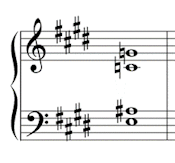Although most chords that you are asked to find at Grade 7 are dominant 7ths, diminished 7ths or Neapolitan 6ths, any other “normal” chord could also come up, including added 7th chords on any scale degree (not just the dominant).
If you are asked to find a specific chord within a score, the wording is often something like “find a dominant 7th chord in the relative major key”.
- First, work out the key in question. For example, if the extract begins in Bb minor, first work out the “relative major key” part – it will be in Db major.
- Then work out what the dominant 7th in Db major is: Ab-C-Eb-Gb.
- Now look at the bass line of the music – this is the easiest way to scan quickly for the information you need. Focus on the part of the stave where Ab lives, and scan quickly looking for a note written in that place. When you see an Ab, check the rest of the chord. Don’t forget to check an octave higher or lower, if necessary, too.
- If you fail to find the note you are looking for, repeat the process with the next chord note (C) in the triad, to see if the chord is in first inversion (you might be told which inversion to search for, in any case).
If you are asked to find an augmented chord, scan the extract for accidentals. There are no augmented triads which can occur without accidentals. An augmented chord contains a major third above the root, and an augmented 5th above the root, e.g. C-E-G#. Remember to stack the chord notes in thirds, to find out what the root is.
If you are asked to find a Ic-Va progression, it is easier if you know the key, but still quite easy if you don’t. In a Ic-Va progression, the bass notes in both chords always use the same letter name. Let’s say you are asked to find the progression Ic-Va in the key of B major:
- Ic is a B major chord with F# in the bass, and
- Va is an F# major chord with F# in the bass.
You need to scan the bass line of the score, looking for two consecutive F#s. They may be in different octaves though, or they may be joined together as one long note, so look carefully.
If you are not told the key of the chords you are searching for, you will still need to scan the bass line looking for two repeated notes or one held note. If you fail to find two repeated notes or one held note, repeat the process but look for an octave leap. Then check that the chords fit.
You may be asked to say whether a given chord is an enharmonic equivalent of another chord. For example, is it true that this chord is an enharmonic equivalent of the dominant 7th in F major? The answer is yes! V7 in F major is C-E-G-Bb. This chord uses the same notes, with Bb spelled as A#.
